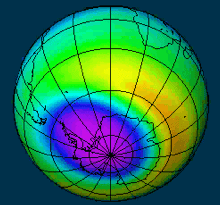
The build up of CFCs and other chlorine and bromine containing species in the atmosphere has lead to significant stratospheric ozone depletion, especially over Antarctic during spring. This ozone depletion leads not only to changes in UV radiation reaching the surface, but also changes in changes in tropospheric weather systems and climate, and ocean circulations. Using observations and a hierarchy of numerical models we are examining the impact of the ozone hole on southern hemisphere weather and climate.
- Seviour WJM, F Codron, EW Doddridge, David Ferreira, A Gnanadesikan, M Kelley, Y Kostov, J Marshall, LM Polvani, JL Thomas, DW Waugh, 2019, The Southern Ocean sea surface temperature response to ozone depletion: A multi-model comparison, Journal of Climate, 32, 5107-5121.
- Seviour, W.J.M, D. W. Waugh, L. M. Polvani, G.J. P. Correa, C.I. Garfinkel, 2017: Robustness of the simulated tropospheric response to ozone depletion, J Climate, , 30, 2577-2585. doi.org/10.1175/JCLI-D-16-0817.1
- Waugh, D.W, C.I. Garfinkel, L.M. Polvani, 2015 Drivers of the recent tropical expansion in the Southern Hemisphere: Changing SSTs or ozone depletion? J Climate, 28, 6581-6588.
- Ndarana, T., D. W. Waugh, L. M. Polvani, G.J.P. Correa, E.P. Gerber, Antarctic Ozone Depletion and trends in tropospheric Rossby wave breaking , Atmos. Sci. Letters, 10.1002/asl.384, 2012.
See more stratospheric ozone papers.
